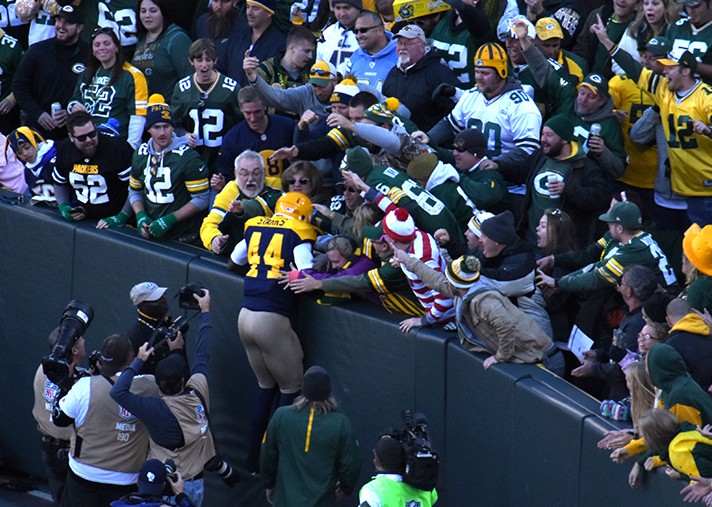
Image Credit: Midwest Communications (CC BY-SA 2.0)
The first Lambeau Leap took place on December 26th, 1993 when Reggie White picked up a fumble and lateraled to defensive back Leroy Butler for a touchdown. Butler entered celebration mode and leaped into the arms of the fans in the first row of Lambeau Field's south end zone. The Green Bay Packers were playing the Los Angeles Raiders in what was the third coldest game in Green Bay Packers history at the time (19 degrees below 0). The Packers went on to shutout the Los Angeles Raiders 28-0.
Green Bay Packers wide receivers Antonio Freeman and Robert Brooks helped the celebration become more popular thereafter since they play on offense and Leroy Butler was a defensive player. Robert Brooks even wrote a song about the Lambeau Leap. Legendary Packers quarterback Brett Favre was a little late to the Lambeau Leap celebration game and didn't take a leap into the Lambeau Field stands until 2006. Aaron Rodgers, on the other hand, did the Lambeau Leap during his first game as a starter in 2008 vs. the Minnesota Vikings.
Leroy Butler would find the end zone only once more before retiring. Charles Woodson is the defensive player with the most Lambeau Leaps at Lambeau Field with four. In 2014, the Green Bay Packers organization erected a statue celebrating the Lambeau Leap tradition outside of Lambeau Field in the Harlan Plaza. The most famous touchdown celebration in the National Football League has it's downsides, however. For one, the jump can be difficult; the end zone walls are six feet high in most areas. Players have also been doused with beer in the often cold Wisconsin temperatures and even grabbed inappropriately by fans. If you'd ask most of the players though, it's well worth the experience and the adrenaline rush. It's also only right that one of the National Football League's most historic teams and stadium has the best touchdown celebration in the entire sport.
Reference:
Related Articles
- Lambeau Field Seating Chart
- Top 5 Best NFL Stadiums for Tailgating
- Breakdown of the Lambeau Field Seating Chart
- Top 5 Best NFL Road Trips
- Green Bay Packers Hotels on the Road
- Hotels Near Lambeau Field
- The "G" on the Packers helmets doesn't stand for "Green Bay"?
- Sports Bars near Lambeau Field

